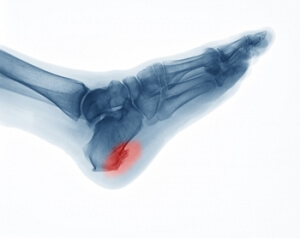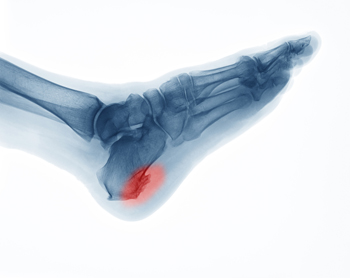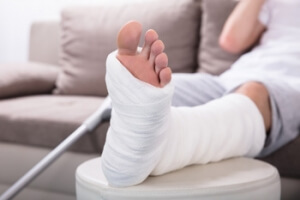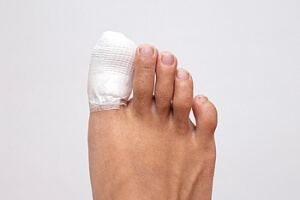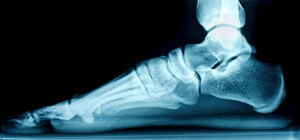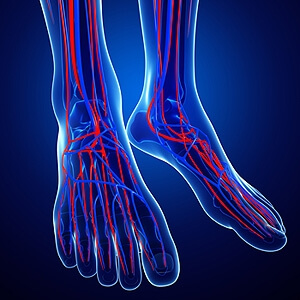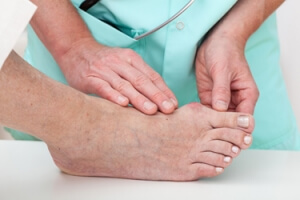Super User
Why Heel Spurs Form
Heel Spurs are calcium deposits that form on the bottom of the heel near the arch. This area of the foot is referred to as the plantar fascia. Heel spurs can occur when the heel bone and plantar fascia are exposed to repeated stress. This type of stress can be due to over-stretching the plantar fascia, habitual tearing of the heel bone’s thin lining, and straining ligaments and muscles in the feet. The stress in this area usually also causes plantar fasciitis (an inflammation of the plantar fascia). Because heel spurs are not always painful, and usually occur along with plantar fasciitis, they can often go undetected. Symptomatic heel spurs can create a sharp pain, inflammation and tenderness, and feel warm to the touch. People who are obese, older, or who wear improper footwear, are more at risk of developing heel spurs, as well as those who participate in activities such as running and jumping repeatedly, or who suffer from osteoarthritis. A podiatrist will typically use X-rays to identify and diagnose heel spurs. If you believe you may have heel spurs, make an appointment with a podiatrist for an examination and analysis of your condition.
Heel spurs can be incredibly painful and sometimes may make you unable to participate in physical activities. To get medical care for your heel spurs, contact Matthew McQuaid, DPM from Lake Mendocino Podiatry. Our doctor will do everything possible to treat your condition.
Heels Spurs
Heel spurs are formed by calcium deposits on the back of the foot where the heel is. This can also be caused by small fragments of bone breaking off one section of the foot, attaching onto the back of the foot. Heel spurs can also be bone growth on the back of the foot and may grow in the direction of the arch of the foot.
Older individuals usually suffer from heel spurs and pain sometimes intensifies with age. One of the main condition's spurs are related to is plantar fasciitis.
Pain
The pain associated with spurs is often because of weight placed on the feet. When someone is walking, their entire weight is concentrated on the feet. Bone spurs then have the tendency to affect other bones and tissues around the foot. As the pain continues, the feet will become tender and sensitive over time.
Treatments
There are many ways to treat heel spurs. If one is suffering from heel spurs in conjunction with pain, there are several methods for healing. Medication, surgery, and herbal care are some options.
If you have any questions feel free to contact our offices located in Lakeport and Ukiah, CA . We offer the latest in diagnostic and treatment technology to meet your needs.
Necessary Care for a Broken Foot
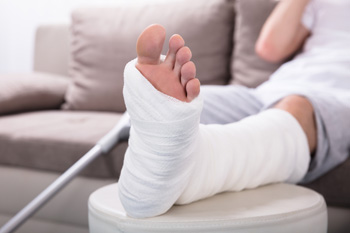 A broken foot can happen as a result of falling or enduring a sudden injury. The healing process can begin when a proper diagnosis is performed, which generally means having an X-ray taken. This is commonly followed by wearing a protective boot or cast, and it may help existing swelling when the foot is frequently elevated. The boot or cast may aid in walking while attempting to complete daily activities. If the fracture is severe, and the bone is protruding from the skin, surgery may be necessary for proper healing. It is suggested that you consult with a podiatrist if you have broken your foot.
A broken foot can happen as a result of falling or enduring a sudden injury. The healing process can begin when a proper diagnosis is performed, which generally means having an X-ray taken. This is commonly followed by wearing a protective boot or cast, and it may help existing swelling when the foot is frequently elevated. The boot or cast may aid in walking while attempting to complete daily activities. If the fracture is severe, and the bone is protruding from the skin, surgery may be necessary for proper healing. It is suggested that you consult with a podiatrist if you have broken your foot.
A broken foot requires immediate medical attention and treatment. If you need your feet checked, contact Matthew McQuaid, DPM from Lake Mendocino Podiatry. Our doctor can provide the care you need to keep you pain-free and on your feet.
Broken Foot Causes, Symptoms, and Treatment
A broken foot is caused by one of the bones in the foot typically breaking when bended, crushed, or stretched beyond its natural capabilities. Usually the location of the fracture indicates how the break occurred, whether it was through an object, fall, or any other type of injury.
Common Symptoms of Broken Feet:
- Bruising
- Pain
- Redness
- Swelling
- Blue in color
- Numbness
- Cold
- Misshapen
- Cuts
- Deformities
Those that suspect they have a broken foot shoot seek urgent medical attention where a medical professional could diagnose the severity.
Treatment for broken bones varies depending on the cause, severity and location. Some will require the use of splints, casts or crutches while others could even involve surgery to repair the broken bones. Personal care includes the use of ice and keeping the foot stabilized and elevated.
If you have any questions please feel free to contact our offices located in Lakeport and Ukiah, CA . We offer the newest diagnostic and treatment technologies for all your foot and ankle needs.
Diagnosing and Treating Various Foot Fractures
 Because of the many bones in the foot, there are a variety of ways that the foot can become fractured. These can include toe fractures, metatarsal fractures (middle of the foot), sesamoid fractures, or fractures to bones at the back of the foot, like the heel bone. A fractured foot will be very painful, especially when putting weight on it, and walking will likely be difficult. In order to properly diagnose a foot fracture, a podiatrist may need to take X-rays. Once X-rays are taken and the fracture is diagnosed, your podiatrist will determine the treatment option that is best for you. Common options include splints, casts, rest, and physical therapy. Most likely, putting weight on the foot will be discouraged for a certain amount of time. If you believe that you have fractured a bone in your foot, make sure to consult with a podiatrist.
Because of the many bones in the foot, there are a variety of ways that the foot can become fractured. These can include toe fractures, metatarsal fractures (middle of the foot), sesamoid fractures, or fractures to bones at the back of the foot, like the heel bone. A fractured foot will be very painful, especially when putting weight on it, and walking will likely be difficult. In order to properly diagnose a foot fracture, a podiatrist may need to take X-rays. Once X-rays are taken and the fracture is diagnosed, your podiatrist will determine the treatment option that is best for you. Common options include splints, casts, rest, and physical therapy. Most likely, putting weight on the foot will be discouraged for a certain amount of time. If you believe that you have fractured a bone in your foot, make sure to consult with a podiatrist.
A broken foot requires immediate medical attention and treatment. If you need your feet checked, contact Matthew McQuaid, DPM from Lake Mendocino Podiatry. Our doctor can provide the care you need to keep you pain-free and on your feet.
Broken Foot Causes, Symptoms, and Treatment
A broken foot is caused by one of the bones in the foot typically breaking when bended, crushed, or stretched beyond its natural capabilities. Usually the location of the fracture indicates how the break occurred, whether it was through an object, fall, or any other type of injury.
Common Symptoms of Broken Feet:
- Bruising
- Pain
- Redness
- Swelling
- Blue in color
- Numbness
- Cold
- Misshapen
- Cuts
- Deformities
Those that suspect they have a broken foot shoot seek urgent medical attention where a medical professional could diagnose the severity.
Treatment for broken bones varies depending on the cause, severity and location. Some will require the use of splints, casts or crutches while others could even involve surgery to repair the broken bones. Personal care includes the use of ice and keeping the foot stabilized and elevated.
If you have any questions please feel free to contact our offices located in Lakeport and Ukiah, CA . We offer the newest diagnostic and treatment technologies for all your foot and ankle needs.
Is My Toe Mildly or Severely Fractured?
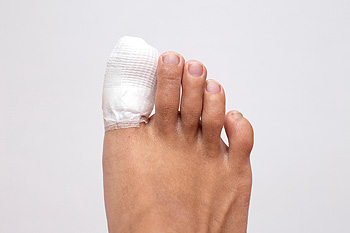 A common injury that many patients can endure is a broken toe. This can be the painful result of a heavy object falling on the toe, or from stubbing the toe against a piece of furniture. Common symptoms that are generally associated with a broken toe include severe pain, swelling, and bruising. If the fracture is severe, the bone may dislocate and protrude from the skin. If the toe is mildly broken, relief may be found by taping the affected toe to the toe next to it. This is referred to as buddy taping, and may provide the necessary stability as the healing process takes place. If you suspect that you have a broken toe, it is strongly recommended that you consult with a podiatrist who can offer you treatment options.
A common injury that many patients can endure is a broken toe. This can be the painful result of a heavy object falling on the toe, or from stubbing the toe against a piece of furniture. Common symptoms that are generally associated with a broken toe include severe pain, swelling, and bruising. If the fracture is severe, the bone may dislocate and protrude from the skin. If the toe is mildly broken, relief may be found by taping the affected toe to the toe next to it. This is referred to as buddy taping, and may provide the necessary stability as the healing process takes place. If you suspect that you have a broken toe, it is strongly recommended that you consult with a podiatrist who can offer you treatment options.
A broken toe can be very painful and lead to complications if not properly fixed. If you have any concerns about your feet, contact Matthew McQuaid, DPM from Lake Mendocino Podiatry. Our doctor will treat your foot and ankle needs.
What to Know About a Broken Toe
Although most people try to avoid foot trauma such as banging, stubbing, or dropping heavy objects on their feet, the unfortunate fact is that it is a common occurrence. Given the fact that toes are positioned in front of the feet, they typically sustain the brunt of such trauma. When trauma occurs to a toe, the result can be a painful break (fracture).
Symptoms of a Broken Toe
- Throbbing pain
- Swelling
- Bruising on the skin and toenail
- The inability to move the toe
- Toe appears crooked or disfigured
- Tingling or numbness in the toe
Generally, it is best to stay off of the injured toe with the affected foot elevated.
Severe toe fractures may be treated with a splint, cast, and in some cases, minor surgery. Due to its position and the pressure it endures with daily activity, future complications can occur if the big toe is not properly treated.
If you have any questions please feel free to contact our offices located in Lakeport and Ukiah, CA . We offer the newest diagnostic and treatment technologies for all your foot and ankle needs.
Do I Have Flexible or Rigid Flat Feet?
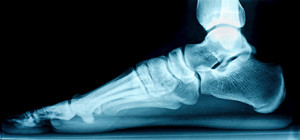 Flat feet is a condition in which the arch, the curved middle part of the bottom of the foot, is absent or has collapsed. The lack of an arch causes the entire sole of the foot to make direct contact with the ground when walking or standing. There are actually two types of flat feet that differ slightly from one another. Flexible flat feet have the ability to form an arch, but this arch flattens when any weight is put on the foot. However, the arch is visible when you are sitting down or holding your foot up in the air. This is the most common type of flat foot. Rigid flat feet cannot form an arch, regardless of whether or not weight is placed on them. While most cases of flat foot do not require medical intervention, sometimes this condition can cause pain or discomfort. In those cases, it is recommended that you see a podiatrist for treatment.
Flat feet is a condition in which the arch, the curved middle part of the bottom of the foot, is absent or has collapsed. The lack of an arch causes the entire sole of the foot to make direct contact with the ground when walking or standing. There are actually two types of flat feet that differ slightly from one another. Flexible flat feet have the ability to form an arch, but this arch flattens when any weight is put on the foot. However, the arch is visible when you are sitting down or holding your foot up in the air. This is the most common type of flat foot. Rigid flat feet cannot form an arch, regardless of whether or not weight is placed on them. While most cases of flat foot do not require medical intervention, sometimes this condition can cause pain or discomfort. In those cases, it is recommended that you see a podiatrist for treatment.
Flatfoot is a condition many people suffer from. If you have flat feet, contact Matthew McQuaid, DPM from Lake Mendocino Podiatry. Our doctor will treat your foot and ankle needs.
What Are Flat Feet?
Flatfoot is a condition in which the arch of the foot is depressed and the sole of the foot is almost completely in contact with the ground. About 20-30% of the population generally has flat feet because their arches never formed during growth.
Conditions & Problems:
Having flat feet makes it difficult to run or walk because of the stress placed on the ankles.
Alignment – The general alignment of your legs can be disrupted, because the ankles move inward which can cause major discomfort.
Knees – If you have complications with your knees, flat feet can be a contributor to arthritis in that area.
Symptoms
- Pain around the heel or arch area
- Trouble standing on the tip toe
- Swelling around the inside of the ankle
- Flat look to one or both feet
- Having your shoes feel uneven when worn
Treatment
If you are experiencing pain and stress on the foot you may weaken the posterior tibial tendon, which runs around the inside of the ankle.
If you have any questions please feel free to contact our offices located in Lakeport and Ukiah, CA . We offer the newest diagnostic and treatment technologies for all your foot and ankle needs.
Flat Feet
Flatfoot is a condition that occurs when the arches on the foot are flattened, which allows the soles of the feet to touch the floor. Flatfoot is a common condition and it is usually painless.
Throughout childhood, most people begin to develop arches in their feet, however, some do not. Those who do not develop arches are left with flatfoot. The pain associated with flat feet is usually at its worse when engaging in activity. Another symptom that may occur with those who have this condition is swelling along the inside of the ankle.
It is also possible to have flexible flatfoot. Flexible flatfoot occurs when the arch is visible while sitting or standing on the tiptoes, but it disappears when standing. People who have flexible flatfoot are often children and most outgrow it without any problems.
There are some risk factors that may make you more likely to develop flatfoot. Those who have diabetes and rheumatoid arthritis have an increased risk of flatfoot development. Other factors include aging and obesity.
Diagnosis for flat feet is usually done by a series of tests by your podiatrist. Your podiatrist will typically try an x-ray, CT scan, ultrasound, or MRI on the feet. Treatment is usually not necessary for flat foot unless it causes pain. However, therapy is often used for those who experience pain in their flat feet. Some other suggested treatment options are arch supports, stretching exercises, and supportive shoes.
Possible Reasons for Ankle Pain
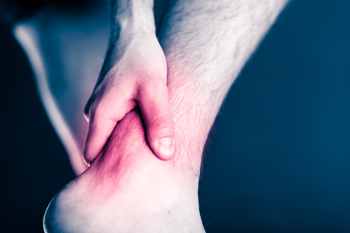 Patients who have experienced ankle pain are aware of the inconvenience this can cause. Daily activities can be difficult to accomplish, and mobility may be limited. There are several reasons why ankle pain may develop. These can include Achilles tendonitis, the arthritic condition that is known as gout, and ankle sprains or fractures. Some of the symptoms that are associated with ankle pain can include swelling, and it may be difficult to bend the ankle. If you are afflicted with any type of ankle pain that is from an injury or medical condition, it is suggested that you seek the counsel of a podiatrist.
Patients who have experienced ankle pain are aware of the inconvenience this can cause. Daily activities can be difficult to accomplish, and mobility may be limited. There are several reasons why ankle pain may develop. These can include Achilles tendonitis, the arthritic condition that is known as gout, and ankle sprains or fractures. Some of the symptoms that are associated with ankle pain can include swelling, and it may be difficult to bend the ankle. If you are afflicted with any type of ankle pain that is from an injury or medical condition, it is suggested that you seek the counsel of a podiatrist.
Ankle pain can be caused by a number of problems and may be potentially serious. If you have ankle pain, consult with Matthew McQuaid, DPM from Lake Mendocino Podiatry. Our doctor will assess your condition and provide you with quality foot and ankle treatment.
Ankle pain is any condition that causes pain in the ankle. Due to the fact that the ankle consists of tendons, muscles, bones, and ligaments, ankle pain can come from a number of different conditions.
Causes
The most common causes of ankle pain include:
- Types of arthritis (rheumatoid, osteoarthritis, and gout)
- Ankle sprains
- Broken ankles
- Achilles tendinitis
- Achilles tendon rupture
- Stress fractures
- Bursitis
- Tarsal tunnel syndrome
- Plantar fasciitis
Symptoms
Symptoms of ankle injury vary based upon the condition. Pain may include general pain and discomfort, swelling, aching, redness, bruising, burning or stabbing sensations, and/or loss of sensation.
Diagnosis
Due to the wide variety of potential causes of ankle pain, podiatrists will utilize a number of different methods to properly diagnose ankle pain. This can include asking for personal and family medical histories and of any recent injuries. Further diagnosis may include sensation tests, a physical examination, and potentially x-rays or other imaging tests.
Treatment
Just as the range of causes varies widely, so do treatments. Some more common treatments are rest, ice packs, keeping pressure off the foot, orthotics and braces, medication for inflammation and pain, and surgery.
If you have any questions, please feel free to contact our offices located in Lakeport and Ukiah, CA . We offer the newest diagnostic and treatment technologies for all your foot care needs.
Different Forms of Neuropathy
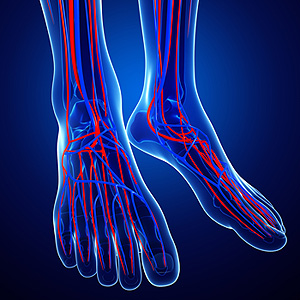 Research has indicated that many patients who have neuropathy may be diabetic. Peripheral neuropathy is defined as nerve damage that can affect the feet, and can happen from elevated glucose levels in the blood. It can cause the inability to feel sensation, and there may be muscle weakness and slowed reflexes. Patients who have autonomic neuropathy may experience difficulty in swallowing, or have abnormal blood pressures and heart rates. Damage that is inflicted on the hips, thighs, or legs may be indicative of radiculoplexus neuropathy, and this may be linked to diabetes. An additional form of neuropathy is referred to as mononeuropathy, and this may cause difficulty in focusing the eyes. If you are experiencing weakness or a lack of sensation in your feet, it is strongly suggested that you are under the care of a podiatrist.
Research has indicated that many patients who have neuropathy may be diabetic. Peripheral neuropathy is defined as nerve damage that can affect the feet, and can happen from elevated glucose levels in the blood. It can cause the inability to feel sensation, and there may be muscle weakness and slowed reflexes. Patients who have autonomic neuropathy may experience difficulty in swallowing, or have abnormal blood pressures and heart rates. Damage that is inflicted on the hips, thighs, or legs may be indicative of radiculoplexus neuropathy, and this may be linked to diabetes. An additional form of neuropathy is referred to as mononeuropathy, and this may cause difficulty in focusing the eyes. If you are experiencing weakness or a lack of sensation in your feet, it is strongly suggested that you are under the care of a podiatrist.
Neuropathy
Neuropathy can be a potentially serious condition, especially if it is left undiagnosed. If you have any concerns that you may be experiencing nerve loss in your feet, consult with Matthew McQuaid, DPM from Lake Mendocino Podiatry. Our doctor will assess your condition and provide you with quality foot and ankle treatment for neuropathy.
What Is Neuropathy?
Neuropathy is a condition that leads to damage to the nerves in the body. Peripheral neuropathy, or neuropathy that affects your peripheral nervous system, usually occurs in the feet. Neuropathy can be triggered by a number of different causes. Such causes include diabetes, infections, cancers, disorders, and toxic substances.
Symptoms of Neuropathy Include:
- Numbness
- Sensation loss
- Prickling and tingling sensations
- Throbbing, freezing, burning pains
- Muscle weakness
Those with diabetes are at serious risk due to being unable to feel an ulcer on their feet. Diabetics usually also suffer from poor blood circulation. This can lead to the wound not healing, infections occurring, and the limb may have to be amputated.
Treatment
To treat neuropathy in the foot, podiatrists will first diagnose the cause of the neuropathy. Figuring out the underlying cause of the neuropathy will allow the podiatrist to prescribe the best treatment, whether it be caused by diabetes, toxic substance exposure, infection, etc. If the nerve has not died, then it’s possible that sensation may be able to return to the foot.
Pain medication may be issued for pain. Electrical nerve stimulation can be used to stimulate nerves. If the neuropathy is caused from pressure on the nerves, then surgery may be necessary.
If you have any questions, please feel free to contact our offices located in Lakeport and Ukiah, CA . We offer the newest diagnostic and treatment technologies for all your foot care needs.
Surgery for Bunions
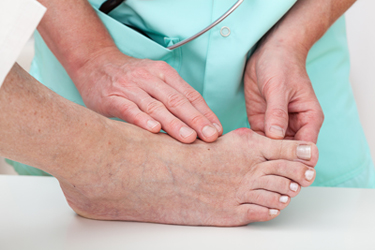 A bunion, also known as hallux valgus, is a common deformity of the big toe. Bunions occur when the joint between the foot and toe is overextended, causing the big toe to bend towards the little toes. In severe cases, the big toe might even go over or under the second toe. This typically results in pain and inflammation, and can even cause arthritis to develop in the big toe. A bunion may sometimes require surgical correction. In cases where less invasive treatments have failed, surgery might be recommended to correct painful misalignment, to fix the deformity before it becomes worse, to reduce mobility restrictions, or to improve the cosmetic appearance of the foot. If you have a painful bunion, it is suggested that you consult with a podiatrist to explore treatment options.
A bunion, also known as hallux valgus, is a common deformity of the big toe. Bunions occur when the joint between the foot and toe is overextended, causing the big toe to bend towards the little toes. In severe cases, the big toe might even go over or under the second toe. This typically results in pain and inflammation, and can even cause arthritis to develop in the big toe. A bunion may sometimes require surgical correction. In cases where less invasive treatments have failed, surgery might be recommended to correct painful misalignment, to fix the deformity before it becomes worse, to reduce mobility restrictions, or to improve the cosmetic appearance of the foot. If you have a painful bunion, it is suggested that you consult with a podiatrist to explore treatment options.
If you are suffering from bunion pain, contact Matthew McQuaid, DPM of Lake Mendocino Podiatry. Our doctor can provide the care you need to keep you pain-free and on your feet.
What Is a Bunion?
Bunions are painful bony bumps that usually develop on the inside of the foot at the joint of the big toe. As the deformity increases over time, it may become painful to walk and wear shoes. Women are more likely to exacerbate existing bunions since they often wear tight, narrow shoes that shift their toes together. Bunion pain can be relieved by wearing wider shoes with enough room for the toes.
Causes
- Genetics – some people inherit feet that are more prone to bunion development
- Inflammatory Conditions - rheumatoid arthritis and polio may cause bunion development
Symptoms
- Redness and inflammation
- Pain and tenderness
- Callus or corns on the bump
- Restricted motion in the big toe
In order to diagnose your bunion, your podiatrist may ask about your medical history, symptoms, and general health. Your doctor might also order an x-ray to take a closer look at your feet. Nonsurgical treatment options include orthotics, padding, icing, changes in footwear, and medication. If nonsurgical treatments don’t alleviate your bunion pain, surgery may be necessary.
If you have any questions, please feel free to contact our offices located in Lakeport and Ukiah, CA . We offer the newest diagnostic and treatment technologies for all your foot care needs.
What to Know About a Broken Toe
The forefoot is composed of five metatarsal bones and fourteen phalanges. Each toe has three phalanges except for the big toe which only has two. Our toes play an essential role to the walking process, which is why a broken toe could seriously disrupt one’s ability to move around. Toe fractures are common and can be very painful. Fortunately, these injuries rarely require surgery and usually heal with rest and a change in activity.
Broken toes typically result from a traumatic event such as falling, stubbing the toe, or dropping something on the toe. Traumatic toe fractures may be categorized as either minor or severe fractures. At times, one may hear a “pop” or “crack” sound when the bone breaks. Common symptoms of a traumatic toe fracture include pain, throbbing, bruising, swelling, and redness.
Another type of toe fractures is a stress fracture. These injuries usually appear in the form of small hairline breaks on the bone. Stress fractures develop after repetitive activity instead of a single injury. Stress fractures occur when the muscles in the bone become too weak to absorb impact. Consequently, the toe bone becomes vulnerable to any pressure and impact it endures. Symptoms for a stress fracture in the toe include swelling without bruising, tenderness to the touch, pain that goes away with rest, and pain after walking or running.
If you suspect that you have a broken toe, you should make an appointment with your podiatrist. He or she will likely diagnose you by performing a physical exam and an X-ray. Treatment for a broken toe may include the R.I.C.E. method, buddy taping, surgery, or antibiotics. The R.I.C.E. method (Rest, Ice, Compression, and Elevation) is a common treatment method for many injuries because it decreases pain. Buddy tapping involves wrapping the injured toe next to an adjacent toe to keep it supported and protected. These two methods have proven to be effective in the healing process for toe fractures. The estimated healing time for a broken toe is approximately four to six weeks. If the injury becomes infected or requires surgery, the estimated healing time may take eight weeks or more.
